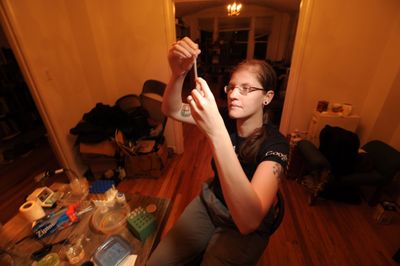Amateurs trying at-home genetic engineering
Movement strikes fear, hope among biotechnology experts

SAN FRANCISCO – The Apple computer was invented in a garage. Google was invented in a college dorm room. Now, tinkerers are working at home with the basic building blocks of life itself.
Using homemade lab equipment and the wealth of scientific knowledge available online, these hobbyists are trying to create new life forms through genetic engineering – a field long dominated by Ph.D.s toiling in university and corporate laboratories.
In her San Francisco dining room lab, for example, 31-year-old computer programmer Meredith L. Patterson is trying to develop genetically altered yogurt bacteria that will glow green to signal the presence of melamine, the chemical that turned Chinese-made baby formula and pet food deadly.
“People can really work on projects for the good of humanity while learning about something they want to learn about in the process,” she said.
So far, no major gene-splicing discoveries have come out of anybody’s kitchen or garage.
But critics of the movement worry that these amateurs could one day unleash an environmental or medical disaster. Defenders say the future Bill Gates of biotech could be developing a cure for cancer in the garage.
Many of these amateurs may have studied biology in college but have no advanced degrees and are not earning a living in the biotechnology field. Some proudly call themselves “biohackers” – innovators who push technological boundaries and put the spread of knowledge before profits.
In Cambridge, Mass., a group called DIYbio is setting up a community lab where the public can use chemicals and lab equipment, including a used freezer, scored for free off Craigslist, that drops to 80 degrees below zero, the temperature needed to keep many kinds of bacteria alive.
Co-founder Mackenzie Cowell, a 24-year-old who majored in biology in college, said amateurs will probably pursue serious work such as new vaccines and super-efficient biofuels, but they might also try, for example, to use squid genes to create tattoos that glow.
Cowell said such unfettered creativity could produce important discoveries.
“We should try to make science more sexy and more fun and more like a game,” he said.
Patterson, the computer programmer, wants to insert the gene for fluorescence into yogurt bacteria, applying techniques developed in the 1970s.
She learned about genetic engineering by reading scientific papers and getting tips from online forums. She ordered jellyfish DNA for a green fluorescent protein from a biological supply company for less than $100. And she built her own lab equipment, including a gel electrophoresis chamber, or DNA analyzer, which she constructed for less than $25, versus more than $200 for a low-end off-the-shelf model.
Jim Thomas of ETC Group, a biotechnology watchdog organization, warned that synthetic organisms in the hands of amateurs could escape and cause outbreaks of incurable diseases or unpredictable environmental damage.
“Once you move to people working in their garage or other informal location, there’s no safety process in place,” he said.
Some also fear that terrorists might attempt do-it-yourself genetic engineering. But Patterson said: “A terrorist doesn’t need to go to the DIYbio community. They can just enroll in their local community college.”